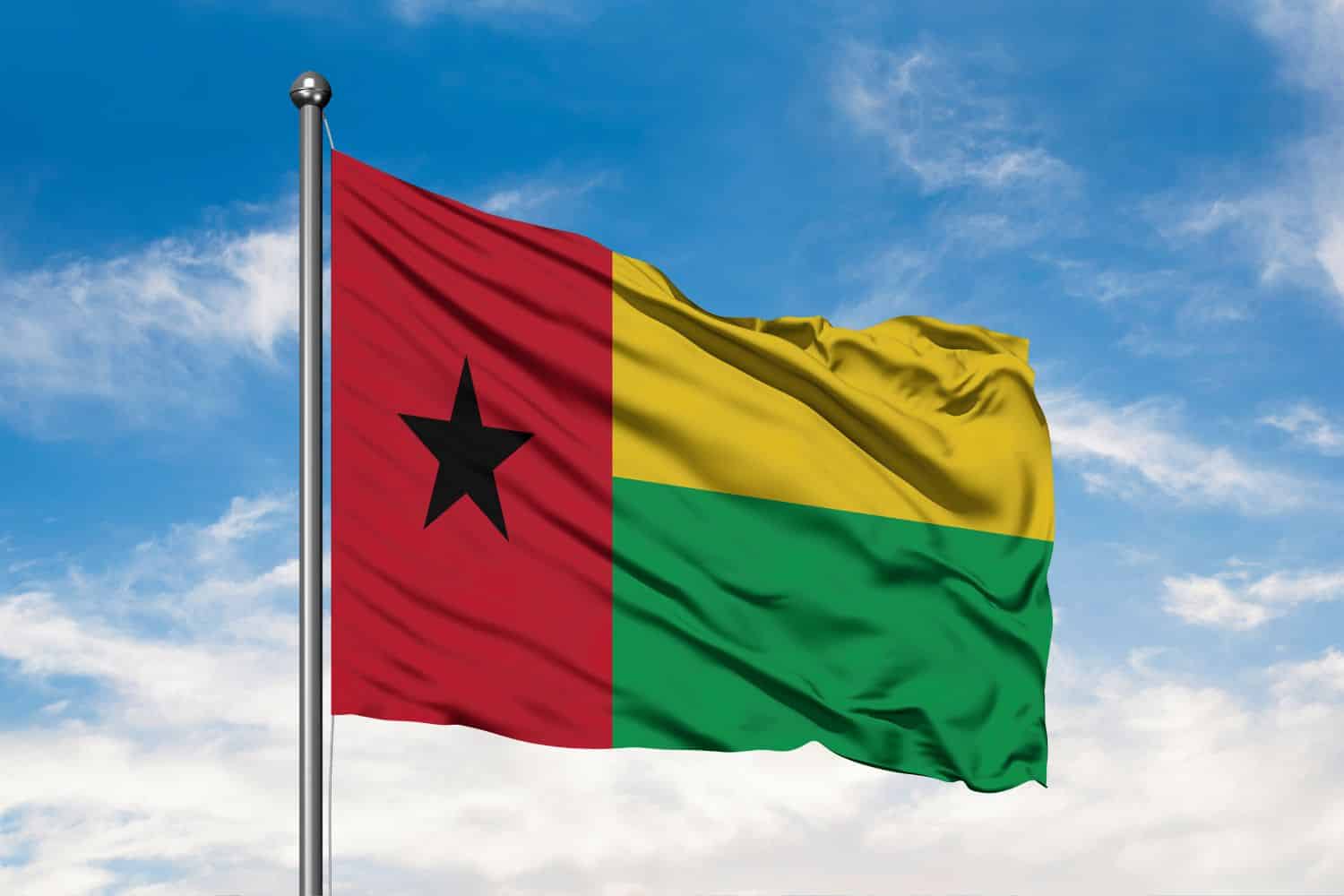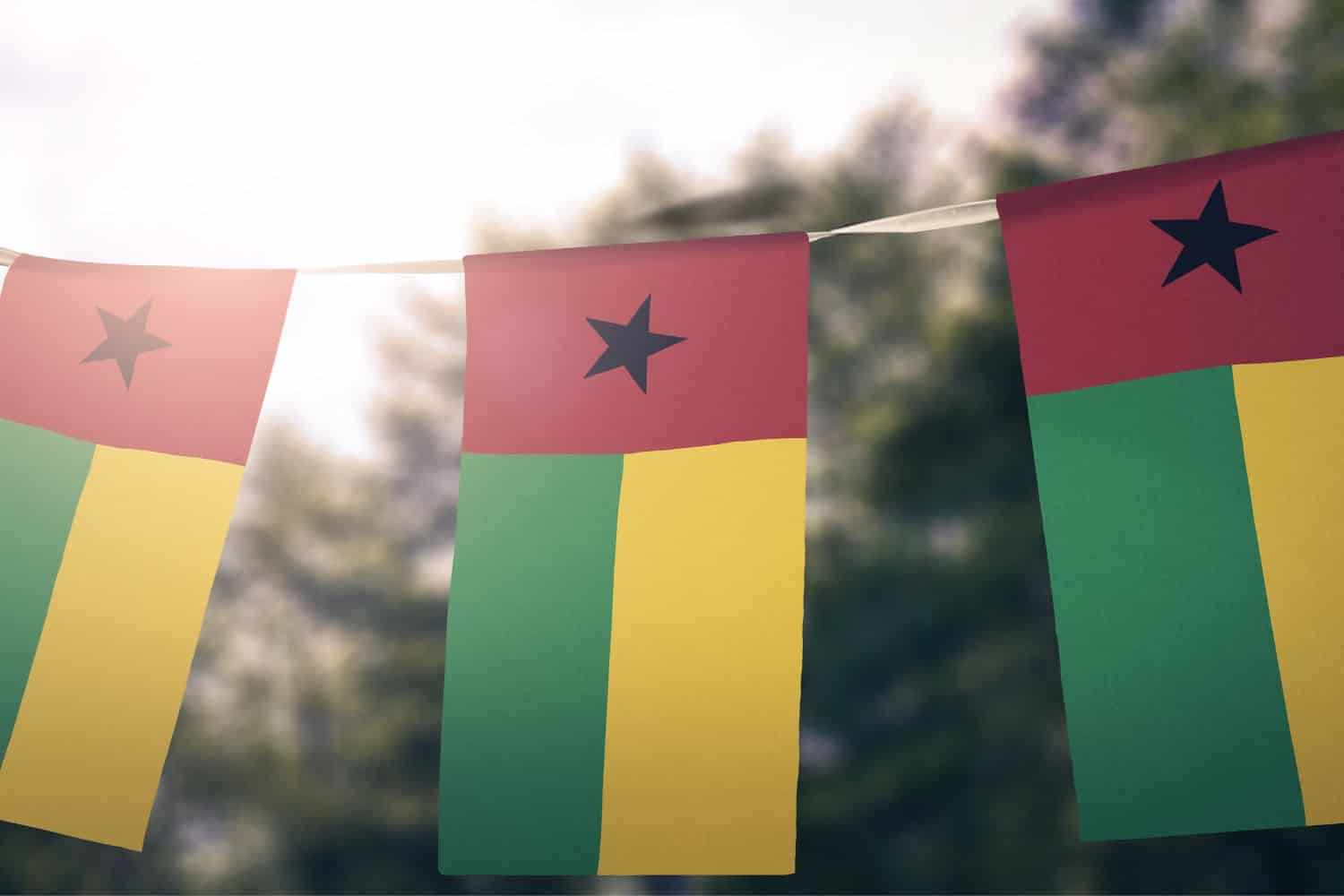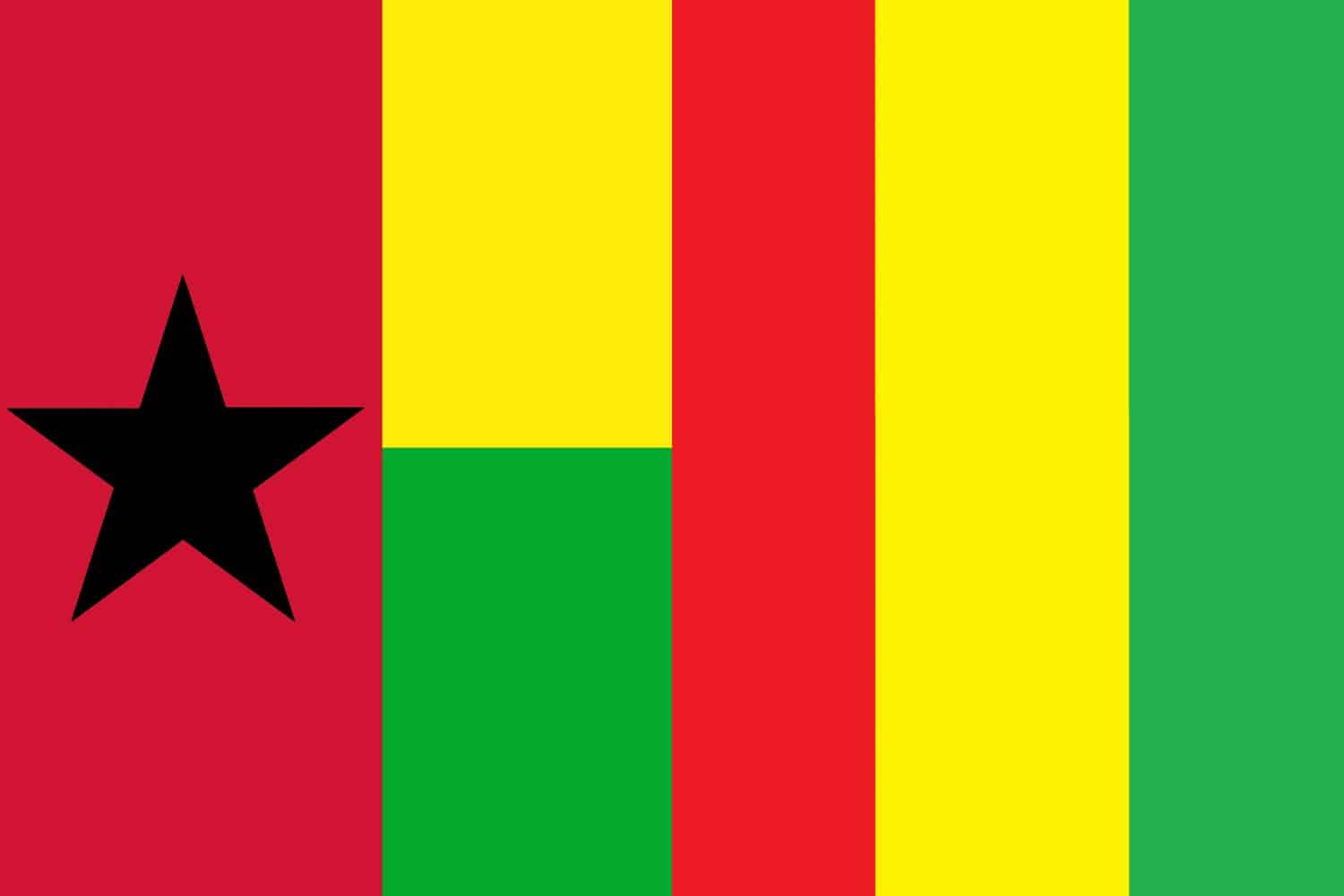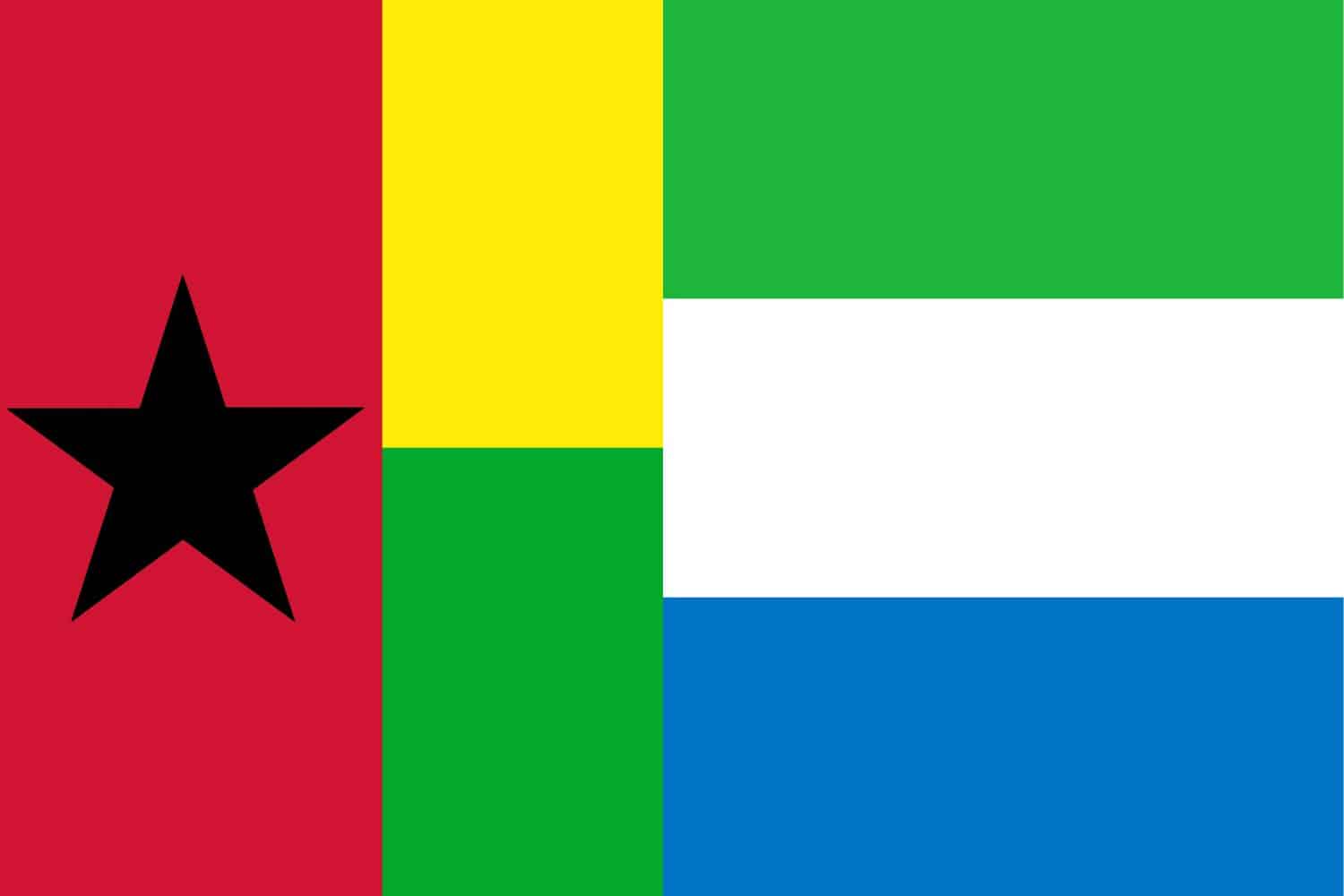Table of Contents
The Guinea Bissau flag, also known as the flag of Guinea Bissau, holds a significant place in the nation’s history and culture. With its vibrant colors and meaningful symbolism, it represents the Guinea Bissau identity and heritage. In this article, we will delve into the intriguing aspects of the Guinea-Bissau flag, its design, historical background, and the symbolism behind its elements.
The Guinea Bissau flag features a vertical red stripe on the hoist side, charged with a black five-pointed star, and two horizontal stripes of yellow (top) and green. The red color symbolizes the blood shed for independence, the yellow represents the sun, and the green stands for the lush vegetation of the country. The black star represents African freedom.
Guinea Bissau Flag: Colors and Symbolism
- The flag of Guinea Bissau features a vertical red stripe with a black five-pointed star and two horizontal stripes of yellow and green.
- The red color symbolizes the blood shed by those who fought for the country’s independence.
- The yellow color represents the sun, shining over Guinea Bissau.
- The green color signifies the lush forests and fertile landscapes of Guinea Bissau.
- The black five-pointed star stands for the freedom and unity of Africa.
- The flag’s design reflects the nation’s aspirations, cultural heritage, and unity among the people of Guinea Bissau.
Flag of Guinea Bissau

The flag stands as a powerful symbol that captures the cultural essence and soul of Guinea Bissau. Its design features a vertical red field on the left side, with two horizontal bands of yellow (top) and green (bottom) on the right side. There’s also a black five-pointed star in the center of the red field. The red color signifies the struggle for independence, the yellow represents the sun, and the green symbolizes hope and the lush forests of Guinea Bissau. The black star holds historical and cultural significance, symbolizing freedom and the African heritage of the country.
The history of the flag is deeply rooted in Guinea Bissau’s rich heritage and its fight for independence. This flag encapsulates the unity and aspirations of the Bissau-Guinean people.
Beyond its aesthetics, the flag from Guinea Bissau carries profound symbolic interpretations. The colors reflect the aspirations and the spirit of the Bissau-Guinean people, symbolizing their struggles, freedom, and hope. The black star, as a symbol of African heritage, represents the unity and identity of the nation. It signifies Guinea Bissau’s rich cultural tapestry and serves as a constant reminder of the nation’s unity and resilience.
National Flag Etiquette and Protocol

Paying respect to the proper usage and display of the Guinea Bissau flag is paramount. Grasping flag etiquette becomes crucial, especially during national events and ceremonies. Familiarize yourself with the rules governing the handling, hoisting, and lowering of the flag. Learn the suitable processes for retiring or handling damaged flags, ensuring they receive the reverence they merit.
- Proper Handling: The Guinea Bissau flag should be treated with the utmost care and respect, ensuring it doesn’t touch the ground or floor. It must always be held upright and not be dragged.
- Hoisting and Lowering: When raising the flag, it should ascend quickly and descend in a ceremonial manner. Typically, it is hoisted at sunrise and lowered at sunset, though this can change based on the event or specific guidelines.
- Displaying the Flag: The Guinea Bissau flag should have the red field on the left with the black star centered, and the yellow and green bands to the right. It must fly freely and remain unobstructed.
- Half-Staff: Lowering the flag to half-staff serves as a sign of mourning or respect. This should be done on designated days of remembrance or as directed by authorities to commemorate national tragedies or the passing of notable figures.
- Flag Retirement: When the Guinea Bissau flag becomes damaged, torn, or faded, it should be retired honorably. This could involve burning it in a dignified and solemn event, adhering to suitable guidelines and local rules.
- Flag Size and Placement: The size of the Guinea Bissau flag displayed should relate appropriately to the size of the flagpole or display region. Consulting local guidelines or officials about particular rules regarding flag size and placement is advisable.
- Respectful Disposal: If a flag cannot be retired by burning, it should be disposed of respectfully. This might include burying it or entrusting it to authorized organizations proficient in flag disposal.
Interesting Facts and Trivia

Embark on a journey of fascinating facts and lesser-known trivia about the Guinea Bissau flag. Discover unique features within the flag’s design that hold hidden symbolism. Uncover stories of famous incidents or events involving the flag that have left an indelible mark on the nation’s history and identity.
Rich Tapestry of History
- 1973: The current flag of Guinea Bissau is adopted on September 24, symbolizing the unity and aspirations of the people of Guinea Bissau.
- Colors and Symbolism: The red color represents the blood shed for independence and the struggle of the people, the yellow stands for the sun and the country’s rich resources, while the green color symbolizes hope, the lush nature, and the agricultural abundance of Guinea Bissau.
- Black Star: Positioned at the center-left of the flag, the black star stands as a symbol of African freedom and the fight against colonialism.
- National Identity: The flag embodies Guinea Bissau’s tumultuous history, diverse cultural heritage, and the nation’s ongoing pursuit of unity, prosperity, and renewal.
Flag-Related Symbols and Emblems
A flag is not alone in representing a nation’s identity. Explore additional national symbols and emblems closely associated with Guinea-Bissau, understanding their significance and how they relate to the flag. Delve into their historical and cultural roots, further enriching your understanding of Guinea-Bissau’s heritage. It’s easy to travel and embark on a Guinea-Bissau tour to visit the country’s best destinations.
Symbolisms of the Guinea Bissau Flag
The flag of Guinea Bissau encompasses several symbolic elements that represent the nation’s history, values, and aspirations. Here are the symbolisms of the Guinea Bissau flag presented in itemized form:
- Yellow Color: Represents the sun and the warmth of the nation.
- Green Color: Stands for the lush forests and agriculture of Guinea Bissau, symbolizing hope and prosperity.
- Red Color: Represents the blood shed for the country’s independence and the courage of its people.
- Black Star: An emblem of African freedom and unity, symbolizing Guinea Bissau’s place in the African continent and its shared destiny with fellow nations.
- Flag’s Design: Mirrors Guinea Bissau’s aspirations, cultural heritage, and unity among its people.
- National Identity: The flag serves as a potent symbol that binds the people of Guinea Bissau, reminding them of their common heritage and cultural identity.
- National Aspirations: Through its design and elements, the flag encapsulates the aspirations and values of the Guinea-Bissau nation, including freedom, hope, unity, and resilience.
These symbolisms in the flag foster the country’s sense of identity and pride, mirroring its historical journey and cultural significance.
Flags of Similar Countries or Regions
Examining the flags of neighboring countries or regions around Guinea-Bissau can provide intriguing insights. Compare and contrast the flags, exploring similarities in design, colors, or symbolism. Uncover historical and cultural connections between flags, shedding light on shared influences or distinctive identities.
Guinea Bissau Flag vs Senegal Flag

Similarity: Both flags feature a green, yellow, and red tricolor pattern.
Difference: The Guinea Bissau flag includes a black five-pointed star in the center of the yellow stripe, while the Senegalese flag has a green star in the center.
Guinea Bissau Flag vs Guinea Flag

Similarity: Both flags have the red, yellow, and green tricolor pattern.
Difference: In the Guinea flag, the colors are arranged vertically, whereas in the Guinea Bissau flag, they are arranged horizontally. Also, the Guinea Bissau flag has a black star on the yellow stripe.
Guinea Bissau Flag vs Sierra Leone Flag

Similarity: Both flags use the green, white, and blue colors.
Difference: The Sierra Leone flag has horizontal stripes of green, white, and blue. The Guinea Bissau flag has a red vertical stripe on the hoist side and horizontal stripes of yellow and green.
Guinea Bissau Flag vs Gambia Flag

Similarity: Both flags use the red, blue, and green colors.
Difference: The Gambia flag has horizontal stripes of red, and blue bordered by white, and green. The Guinea Bissau flag uses a different design with a vertical red stripe, a black star on the yellow stripe, and a green stripe.
Guinea Bissau Flag vs Mali Flag

Difference: In the Mali flag, the colors are arranged vertically with no additional symbols. The Guinea Bissau flag has a black star in the yellow stripe and the colors are arranged differently.
Guinea Bissau Flag vs Liberia Flag

Similarity: Both flags incorporate the color red.
Difference: The Liberian flag looks similar to the U.S. flag with red and white stripes and a blue square with a white star in the top left corner. The Guinea Bissau flag has a different tricolor pattern and a black star on the yellow stripe.
Frequently Asked Questions (FAQs)
Discover answers to common questions related to the Guinea Bissau flag picture. From its historical origins to the symbolism behind its elements, find concise and informative responses that address inquiries commonly posed by those curious about Guinea Bissau’s flag.
What do the colors of the Guinea-Bissau flag represent?
The red represents the blood shed for independence, the yellow symbolizes the sun and the savannahs, and the green stands for the forests and natural wealth.
Why is there a black star on the Guinea-Bissau flag?
The black star is a symbol of African freedom and represents the African people.
When was the Guinea-Bissau flag adopted?
The flag was adopted on September 24, 1973, shortly before Guinea Bissau declared its independence from Portugal.
Who designed the Guinea-Bissau flag?
The flag is based on the flag of the African Party for the Independence of Guinea and Cape Verde (PAIGC), the main movement that fought for Guinea Bissau’s independence. The exact individual designer is not widely credited.
How similar is the Guinea Bissau flag to other African flags?
The tricolor pattern and the use of a star are motifs found in several African flags, inspired by Pan-Africanism. However, the specific arrangement and the placement of the black star in the yellow stripe make it distinctive.
Is the Guinea-Bissau flag influenced by the Ghanaian flag?
Yes, the black star on the Guinea Bissau flag is believed to have been inspired by the black star on the Ghanaian flag, which itself represents African freedom.
How is the flag of Guinea Bissau different from the flag of Guinea?
While both flags use red, yellow, and green, their arrangements differ. Guinea Bissau has a horizontal arrangement with a black star in the yellow stripe, while Guinea’s tricolors are vertical with no star.
What is the correct way to display the Guinea Bissau flag vertically?
When displayed vertically, the red stripe should be on the left, followed by the yellow stripe with the star, and then the green stripe on the right.
Have there been any other flags before the current one for Guinea Bissau?
The current flag has been in use since the country’s declaration of independence in 1973. Before that, as a Portuguese colony, the region would have used the flag of Portuguese Guinea.
Is the flag of Guinea Bissau and Cape Verde similar due to their historical connection?
While both nations have historical ties through the PAIGC, their flags are different. Cape Verde’s flag has a blue field with a circle of stars, while Guinea Bissau’s flag follows the Pan-African colors with a black star in the center of the yellow stripe.
More About Guinea Bissau
[the-post-grid id=”50365″ title=”Guinea Bissau Main page”]
